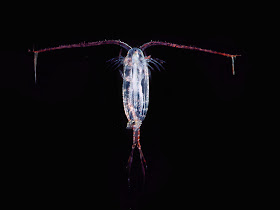 |
| Image via Wikipedia |
Copepods most come into their own at surface waters, where they are a major component of plankton and dominant within zooplankton. Whenever you hear about a big animal that eats plankton, copepods will be an extremely important part of their diet. Especially since those guys aren't actually vegetarian. Copepods themselves might eat various things. Some are herbivorous, taking individual cells of phytoplankton. They in turn could get eaten by other, larger copepods. The ones that live at the bottom of seas and lakes can eat detritus that has drifted down, or they could leave it for bacteria and eat them instead.
Copepods are so tiny and their exoskeleton so thin, that they appear transparent. They still have to moult though. It's also so thin that most of them lack gills and simply breathe through their armour. And of course, they eat. Food in the gut is encased in a tiny, thin bag and is called a food pellet, which later becomes a faecal pellet as it passes through and out. These moulted exoskeletons and droppings really do drop. Deep sea copepods could even be eating the leftovers of their surface dwelling cousins! This, coupled with the sheer mind boggling numbers of these guys, means that copepods are extremely important as carbon sinks. Carbon is taken from the air by diatoms and the like, it goes on to copepods and is then flushed down into the depths as detritus. Some believe they are even more important for this than Antarctic Krill, another crustacean that can be found in ridiculous numbers. Copepods are nowhere near as big as krill, though, it's just that their numbers... let's just say that through sheer density, they can sometimes make the sea look a little pink.
This kind of stuff isn't really at the forefront of the copepod's tiny mind. They just wanna eat, breed and not die. Like most crustaceans, they have 2 pairs of antennae. Unlike most crustaceans, they have just one eye. That's not so great. Luckily, they also have remarkably sensitive bristles on their body so that they can feel the flow of water around them. This warns them of the presence and movement of predators and prey.
One pair of their antennae are very long and are used to stop them sinking. Their mouth parts can filter out food by creating a flow of water through them, which also helps with swimming. Can you believe that? They're so small they can use their mandibles to swim! Females can even do this when they are weighed down by the little sacks of eggs they carry around with them, although others don't bother with that and just release them into the sea.
Copepods also have 4 or 5 pairs of legs that can be used for faster travel and in emergency situations. They may seem unassuming, but many copepods have remarkably advanced nerves in their tiny bodies. Unlike almost all invertebrates, their neurons are sheathed in a well organised wrapping of myelin. This speeds up electrical impulses for quick reactions. And the reaction? A beat from those spare legs allow these copepods to leap away at a rate of half a metre per second (video). For their size, this is said to be 10 to 30 times stronger than any other animal yet tested! It's for their eeny, weeny size, though. I could still take 'em. Yeh, bring it on, *grunt*.

Don't pick a fight with the copepod! He has a lot of friends!
ReplyDeleteHey... you know, that's a good point. Once I get a few million friends of my own though, those copepods won't stand a chance!
ReplyDelete